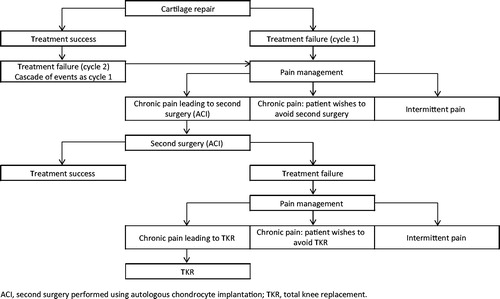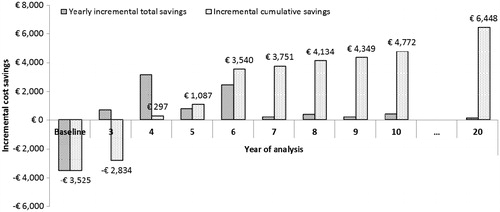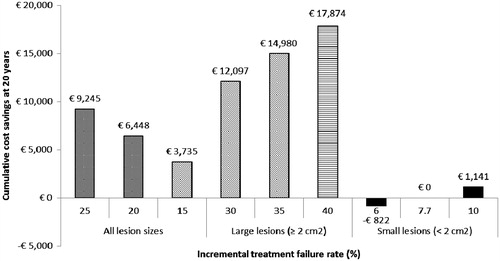Figures & data
Figure 1. Graphic of the decision tree model used to infer the economic evaluation. Patients enter the model at the point of cartilage repair, which is undertaken with either the device as an adjunct to microfracture or microfracture alone and subsequently follow a cascade of events.

Table 1. Baseline characteristics of subjects treated with the device as an adjunct to microfracture and microfracture only in the RCT driving clinical outcomes in the decision tree modelCitation31.
Table 2. The incremental difference in proportion of patients failing the threshold lesion fill rate assumed for treatment success (70%), and the resultant incremental treatment failure rates (at 3 years post-initial intervention), with the device vs microfracture alone, for all lesion sizes, lesions ≥2 cm2 and lesions <2 cm2.
Table 3. Resource use assumptions for all treatments post-failure of initial intervention, presented as a proportion of patients undergoing the intervention who incur the resource use (weighted risk) and the amount of resource use incurred (resource intensity). Assumptions based on independent market researchCitation41 and validated by the Delphi panel.
Table 4. Unit costs for resource use applied in the economic analysis in Euros, using Germany as a reference.
Figure 2. Cumulative incremental cost savings (€) for the device vs microfracture alone, at time-horizons up to 20 years (no cost savings are realized in years 1 and 2, since treatment failure is assumed to occur in year 3 in cycle 1 and year 5 in cycle 2). Costs are discounted at a rate of 3.0% per annum.

Table 5. Base case incremental cost savings (€) for the device vs microfracture alone, at time-horizons up to 20 years (no cost savings are realized in years 1 and 2, since treatment failure is assumed to occur in year 3 in cycle 1 and year 5 in cycle 2; ‘…’ indicates ongoing resource use between years 10 and 20). Results are presented for cycle 1 and cycle 2 and as yearly and cumulative incremental total cost savings. Costs are discounted at a rate of 3% per annum.
Figure 3. Cost savings (€) for the device vs microfracture alone, at 20 years for each scenario analysis. Costs are discounted at a rate of 3.0% per annum.

Table 6. Incremental cost savings (€) for the device vs microfracture alone, at time-horizons up to 20 years for each scenario analysis (no cost savings are realized in years 1 and 2, since treatment failure is assumed to occur in year 3 in cycle 1 and year 5 in cycle 2; ‘…’ indicates ongoing resource use between years 10 and 20). Results are presented as cumulative incremental cost savings. Costs are discounted at a rate of 3.0% per annum.
